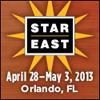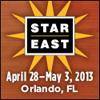 |
Mobile Testing Tools 101
Slideshow
The burgeoning use of mobile devices has created enormous opportunities for organizations to leverage mobile to increase sales, advertise products, and collaborate with internal and external resources. However, with increasing usage, the need to perform testing on these devices is...
|
David Dang, Zenergy Technologies, Inc.
|
 |
Think Different: Visualization Tools for Testers
Slideshow
Traditional processes have required testers to create a large amount of documentation in the form of test plans, test cases, and test reports. It’s time to think differently. Creating test artifacts in the “old school” textual style takes too much time away from actual testing.
|
Pascal Dufour, codecentric
|
|
|
Back to the Basics: Principles for Constructing Quality Software
Slideshow
Using an analogy to the building codes followed by architects and contractors in the construction of buildings, Rick Spiewak explores the fundamental principles for developing and delivering high quality, mission-critical systems. Just as buildings are constructed using different materials and techniques, we use a variety of languages, methodologies, and tools to develop software. Although there is no formal "building code" for software, software projects should consider-and judiciously apply-the recognized "best" practices of static analysis, automated unit testing, code re-use, and peer reviews. Rick takes you on a deep dive into each of these techniques where you'll learn about their advantages, disadvantages, costs, challenges, and more.
|
Rick Spiewak, The MITRE Corporation
|
|
|
It's a Phone First! How to Test Your Five-star Mobile Apps
Slideshow
Mobile application development shares many similarities-and some stark differences-with traditional web-based development. To build, test, and deploy five-star mobile applications, your organization needs-from inception-a focused test strategy to drive quality. Employing the wrong approaches and tools can leave your business sponsors and clients wondering what went wrong. Will Hurley outlines the current mobile landscape and explains what can and cannot be controlled in the mobile lifecycle. He explores the current landscape and limitations on tools for testing mobile apps, and offers guidance on what-and what not to-automate. With Will's guidance, you’ll learn how to establish a mobile lifecycle test strategy that is both leading edge and practical.
|
Will Hurley, Will Hurley - Quality and Security Services
|
|
|
Cross-platform Testing at Microsoft Microsoft Office products have been available on Windows-based and Apple Mac personal computers for many years. Now, with the rapid proliferation of mobile device platforms, current testing strategies are more difficult to justify because it is not feasible to implement test suites from scratch for each new mobile platform that arrives in the market. Join Jean Hartmann in an exploration of the platform-agnostic testing space and learn about current cross-platform strategies, tools, and processes being developed within Microsoft Office. Jean presents examples to help you gain a better understanding of the benefits, challenges, and trade-offs that you must make when considering such approaches. To start the process of developing the new strategies, tools, and processes, you’ll need to create portable tests in which testers define their core test scenarios once and then leverage them for different platforms and devices.
|
Jean Hartmann, Microsoft Corporation
|
|
|
Application Lifecycle Management Imperatives Ever growing software development needs and faster delivery cycles coupled with flat or shrinking IT budgets have brought many organizations to new agile and lean practices. Together, these disruptions are causing a sea of change in the application lifecycle management (ALM) landscape. Although management tools aren’t an explicit focus for most development teams, choosing the right tools for enterprise development is an important factor in keeping everyone productive. Monica Luke discusses the five key imperatives for ALM implementations: in-context collaboration, accelerating time to delivery with real-time planning, improving quality with lifecycle traceability, refining predictability with development intelligence, and reducing costs through continuous improvement. For each imperative, Monica offers concrete examples and lessons learned from real-world implementations. Don’t get lost in the weeds with an ALM tool.
|
Monica Luke, IBM Rational Software
|
|
|
Let's End the Defect Report-Fix-Check-Rework-Cycle Find out how teams transitioning to Agile practices must re-think their workflows and project metrics originally designed to handle many hundreds of defect reports that occur in typical testlast development cycles. Richard Leavitt discusses how a real-world implementation of key practices like early testing and continual integration-though not without bumps and bruises-lowered the number of open defect reports by an order of magnitude. These practices also can improve how the team communicates, reduce delays, and provide more direct measures of project status, feature progress, and release readiness.
|
Richard Leavitt, Rally Software Development
|
|
|
Choosing an Automated Web Application Testing Solution: What You Need to Know The Internet has injected critical changes into how businesses must guarantee the quality of their enterprise applications. Automated testing tools are no longer optional for organizations that want to gainand-maintain-he highest level of quality control over their eBusiness applications. Selecting a Web testing tool is not an easy job in today's fast-paced market. This presentation defines and discusses the top requirements for an automated testing solution in the Internet age. Discover why Web testing is different from Client/Server testing. Explore the points of failure and critical technologies to test in a Web application. Learn the key criteria to use when selecting a testing tool: ease of use, accuracy, and reporting.
|
Yves de Montcheuil, Empirix
|
|
|
Succeeding with Automation Tools The problems with using record/playback as your only test automation strategy are well known. But the other option-full script programming-is unattractive to many due to its high cost and long development time. This presentation discusses a strategy called defensive programming that incorporates the best of both worlds. Learn how to leverage your automation tool with simple implementation techniques to create robust test suites.
|
Jamie Mitchell, BenchmarkQA
|

